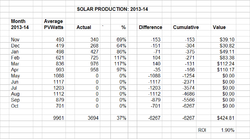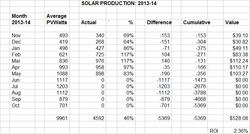One last important detail is buy a can of Never Seize, most of the fasteners are stainless steel and the quality may not be great, one little burr on a stainless thread can turn into galled fastener and the only way to get it apart is by breaking it or cutting it off. A dab of never seize on the threads does wonders and if you ever need to take them apart, that one extra step will be paid for. Many folks over do it and it can get messy.
I was fortunate that FL allows me to wear all the hats if I'm putting a PV system on my own house. As the designer, FSEC PV system certification holder, building permit holder, installer, and end user of my system, I agree with Peakbagger's comments. The value of installing a system yourself is in your ability to handle all the fine details. I had my bottle of never seize on the roof with me. A box of disposable nitrile gloves goes a long way toward keeping the mess down when using that stuff, and keep a rag handy. My system used black anodized panel frames and rails, I paid particular attention not to get the silver anti-seize paste all over everything. I learned long ago that the metallurgical properties of cutting threads in stainless steel is what causes galling problem that Peak described. I've had to break a $4 1/2" stainless hex bolt, because I failed to use never seize on it. I'm not a big guy, and it took a 4' pipe on my 1/2" drive tools to shear that bolt after the nut bound up in both directions. (I live on a salt water canal, all my floating dock hardware is 1/2" 316 grade stainless steel fasteners). I can't afford to throw away $4 stainless bolts all day long...
When I installed my PV system, I found the local big box hardware store had stainless steel tie wraps, on clearance. I put heat shrink tubing around every stainless tie wrap to separate the stainless from the black anodized aluminum rack rails. I used these for all my trunk cable management instead of the typical wiley wire clips. Even in a hurricane, my trunk cable will not move or come unclipped. All my tie wraps are hidden under the panels, out of direct sunlight. My building inspectors quickly noticed the heat shrink wrapped stainless tie wrap detail, as well as the Hubbell Weigmann NEMA 4X hinged lid fiberglass enclosure I used as a junction box on the roof for my transition from Enphase trunk cable to 12/4 TC-ER sunlight and oil resistant cable to feed down the weather head through the roof. Instead of wire nuts, I used UL rated industrial automation DIN-Rail terminal blocks on DIN rail mounted to the non-metallic back-panel to splice my 12AWG wires inside the fiberglass enclosure. My PV combiner panel is a 100A Square-D QO series breaker panel, sized for future system expansion. I have extras of every NEC warning label in my system, if sunlight fades them in 10 years, I'll just replace them. When you have the liberty of picking every item in your system, you can use the quality you choose. I tried to design my system to be as trouble free as possible for as long as possible. The weather in South Florida is rough on things left outside 24/7. My use of the fiberglass NEMA 4X enclosure was based on experience using them at aquatic theme parks around salt water.
Having purchased a high end "stud finder" a model suggested by my structural engineer, I fully recommend using the framing hammer thump method to locate your trusses. I had to put 204 5/16"x3" stainless lag bolts into my trusses to attach my 102 creotecc tile hook mounts to the roof structure to meet my local design criteria to withstand a 3 second gust of 170mph. Despite having tongue and groove roof decking, the framing hammer thump method proved more reliable than electronic means for locating my trusses.
My install took over a week just to get all 102 tile hooks bolted to the trusses, and to put my metal tile roof back together. Ladder up to ladder down took two months, but I only took a week off from work to get as much done as I could, so that basically covered dismantling my metal tile roof, the mounting of the tile hooks to the roof trusses, putting the roofing back on, and approximately mounting the 6 rails for two rows of panels. (yes to get the three second 170mph gust wind load rating, I have three rails supporting every panel!). After the first solid week of work, I was cut back to evenings and weekends and calendar time flies when you have only evenings and weekends to accomplish stages of the project between in-progress inspections for electrical and structural work (which can only be scheduled on weekdays). I too had to pull wire from the second story attic down to a panel on the outside of the ground floor of the house. I chose to pull the wire through the walls rather than slapping an ugly conduit on the outside of the house. I installed special nailer boards in the attic just to attach and route my pair of 10/3+gnd UF wires and 6AWG ground wire. When my inspectors saw my 220V wiring through the attic, they said no licensed electrician ever wires anything that neatly.



